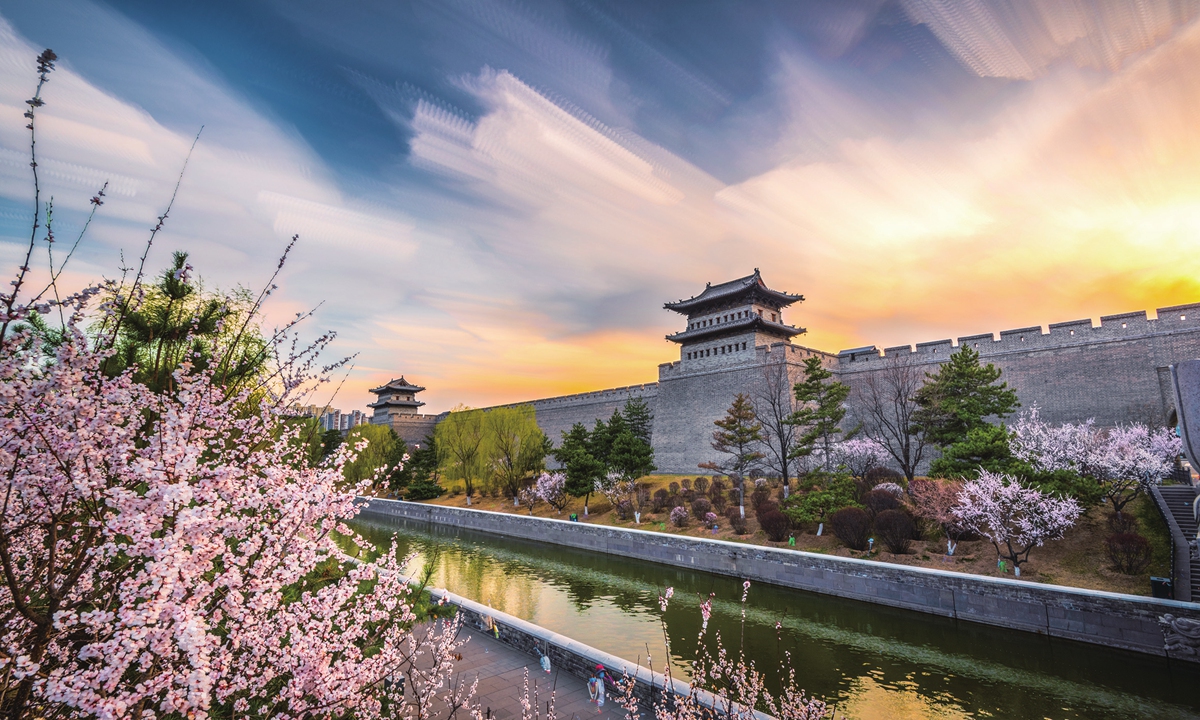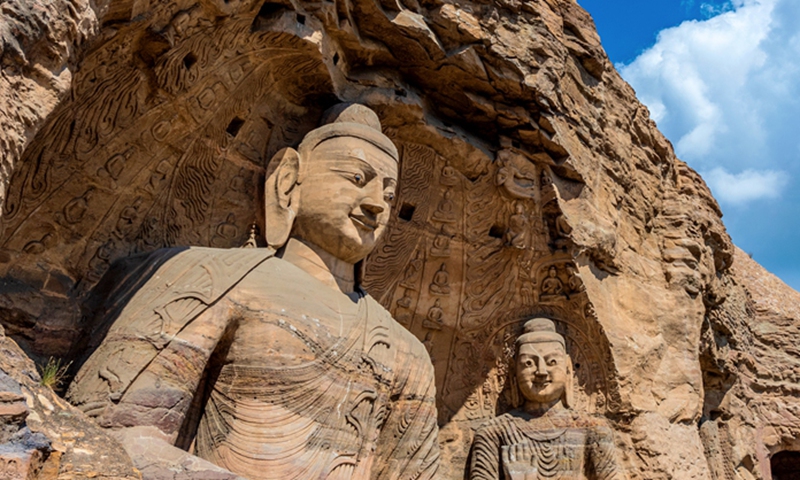
A general view of the Yungang Grottoes Photos: VCG
Starting from April, Datong, the ancient capital of the Northern Wei Dynasty (386-534) located in North China's Shanxi Province, embodies a rich blend of grandeur and romance. During the Qingming Festival holidays, the city launched its special 2025 Spring Flower Viewing Map, drawing people from around the country to traverse a landscape where millennia-old ancient architecture blends with the vibrant embrace of springtime blossoms.Map in hand, visitors navigate their way through centuries of history, discovering the connection between the city's historical sites and the stunning floral displays that accompany them. Ding Hao, a local tour guide with 13 years of experience, told the Global Times that no matter how many times he has seen it, he always finds that Datong in spring has a unique charm.
Timeless dialogue
While exploring the Yungang Grottoes, a tourist surnamed Bi from Beijing, shared: "My son is very passionate about Chinese history and these caves have always been one of his must-visit destinations," adding that her family decided to spend their entire three-day holidays in Datong.
What they saw in the scenic area made them rediscover the beauty of the grottoes, which boast a large array of mesmerizing stone carvings and offer a window on the history of a dynasty.
Located at the southern foot of the Wuzhou Mountain in Datong, the Yungang Grottoes, carved more than 1,500 years ago, are among the largest Buddhist grotto temples in China. Housing over 51,000 Buddhist statues presenting distinct designs, they form a cultural treasure house of ancient Buddhist and stone carving art, fusing elements of Chinese, foreign, ethnic minority, and Central Plains cultures.
Among the many exquisite examples of Buddhist statues stands the iconic outdoor statue of Buddha of the 20th grotto, which is a colossal statue carved into the sandstone cliffs over 1,500 years ago, during the Northern Wei Dynasty.
The Buddha's finely chiseled features, including its gentle smile and intricately detailed robes, reflect the exceptional craftsmanship of ancient artisans. Bathed in natural light, the statue radiates a timeless beauty that captivates visitors and serves as a testament to the enduring legacy of Buddhist culture in China.
Surrounded by the delicate hues of apricot blossoms in spring, the Buddha becomes a striking union of history and nature, offering a profound and unforgettable experience to all who visit.
Early mornings are the best time to visit, according to Ding. The soft sunlight bathes the grottoes in a warm glow, accentuating the intricate carvings and creating a striking interplay of light and shadow. The addition of blooming apricot trees transforms the scene into a springtime masterpiece - one that feels like stepping into a painting from another era.
Bi and a couple from South China's Guangdong Province described this experience as a dialogue across centuries: the steadfast serenity of the Buddha statues contrasts with the fleeting beauty of the blossoms, reminding us of both the permanence of history and the transience of nature. Wandering through the apricot blossom corridor beside the grottoes, one cannot help but feel a sense of awe and connection to the past, as if the whispers of ancient monks could still be heard among the rustling petals.

Peach and apricot blossoms bloom nearby the city wall of Datong, North China's Shanxi Province.
A living poemIn the heart of Datong's ancient city lies Huayan Temple, one of the best-preserved Liao and Jin dynasties (916-1234) temple complexes in China. This architectural marvel, dating back nearly 1,000 years, is a testament to the skill and vision of ancient craftsmen. During spring, the monastery's courtyards come alive with the vibrant hues of blooming lilacs and apricot trees, creating a scene of unparalleled beauty.
Strolling through the monastery's tranquil grounds, the sweet fragrance of lilacs mingles with the scent of incense wafting from the temple halls delights the senses. The juxtaposition of the ancient wooden structures, with their intricate carvings and faded paint, against the fresh vitality of spring blossoms creates a powerful visual and emotional experience. It is a place where history feels alive, not just because of the well-preserved buildings, but in the way nature becomes a part of the story.
The flower-lined paths of Datong's ancient city walls also offer a glimpse into the city's storied past as a strategic military hub. As April arrives, the walls are flanked by rows of apricot trees bursting into bloom, their pink and white flowers forming a natural "flower path" that winds through the city.
Like other places that are seeking an eco-friendly transformation around China, Datong, once a major coal-mining hub often referred to as China's "coal capital," shifted away from its industrial past. It has embraced its rich cultural and historical heritage as a focal point for sustainable tourism and economic revival. From the apricot blossoms at the Yungang Grottoes, to the lilac-filled courtyards of the Huayan Temple, and the flower-lined paths along the ancient city walls, each stop offers a unique perspective on the city's rich history and natural beauty. Standing on the river bank and looking into the distance at the former coal mines, Ding shared his feelings:
"In Datong, spring is not just a season; it is a living poem, where ancient architecture and vibrant blossoms come together to tell a story of resilience, beauty, and renewal."


